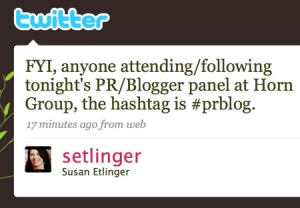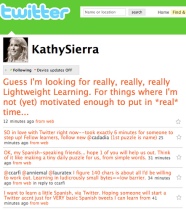To Tweet or Not to Tweet: How to Use Twitter to Build Your Cleaning Business
If you’re trying to establish a new cleaning business (or to expand your existing business’s customer base), it’s likely that you’re considering taking advantage of social media platforms like Facebook, Twitter, YouTube and the like. After all, these tools offer ways to directly connect with potential customers—and they’re free!
But there’s a big gap between the abstract idea that Twitter “would be good for” your cleaning business and actually using Twitter to build your business up.
So let’s begin at the beginning.
What is Twitter?
Some describe Twitter as a “virtual networking event,” others as a “micro-blogging platform.” Who’s right? Well, they both are.
In essence, Twitter is a web site that allows you to register a personal or business profile, which you can use to post updates, or “Tweets.” Other Twitter subscribers see your Tweets when they “follow” you; likewise, you see theirs when you “follow” them.
Tweets from the accounts you follow are compiled into a “stream,” which updates in real time. Thus, if your friend Mike is at the hardware store and he posts a photo to Twitter of the expensive new drill he just bought, you’ll see it before his wife does (and maybe that’s for the best.)
All Tweets must come in at under 140 characters, but you can post as often as you want (hence Twitter’s “micro-blogging” label.) You can also use Twitter to post links, videos and other media.
Why Should You Use Twitter?
The short answer: 460,000 Twitter accounts are created every day. In other words, Twitter is huge, and getting bigger.
Many of your customers, prospects and business contacts likely have Twitter accounts—and those who don’t may be creating them as we speak. Why not utilize this free method for keeping in touch with them? You can also leverage Twitter in order to make new contacts and build new customer relationships.
How to Make Twitter Work for You
Tip #1: Stay Local
Many businesses join Twitter and then follow accounts at random, not thinking about which contacts are most likely to lead to actual sales down the line.
If you’re trying to build up your cleaning business’s clientele, then you should only follow Twitter accounts that are based in your region. After all, what use is a Tokyo Twitter follower when you’re located in Denver? You wouldn’t be able to clean her carpets without taking several connecting flights!
 In order to search on Twitter for local accounts, you’ll need to use Twitter’s keywords, which are called hash tags. Hash tags are always preceded by the pound sign (#) and never contain spaces. Thus, for example, if you were Bellingham, WA-based and wanted to look for accounts located in your county, you’d search Twitter using the hash tag #WhatcomCounty.
In order to search on Twitter for local accounts, you’ll need to use Twitter’s keywords, which are called hash tags. Hash tags are always preceded by the pound sign (#) and never contain spaces. Thus, for example, if you were Bellingham, WA-based and wanted to look for accounts located in your county, you’d search Twitter using the hash tag #WhatcomCounty.
Tip #2: Meet the Press
Whether they write for the New York Times or the Podunk Daily Mail, journalists all use Twitter to keep abreast of the latest national and regional news developments. Nowadays, Twitter is used to break every story from the fire down at the junk yard to scandalous political gaffes.
By following your local media on Twitter, you can motivate them to follow you back. This can result in invaluable press for your business. Some suggestions:
- If a local journalist asks for story ideas on Twitter, submit one about your business’s success story.
- When your company makes a big change, write up a press release about it and post it to your website. Tweet the link to your followers. The press just might report on your news.
- Journalists often tweet about major community changes. By tracking these, you could discover new business opportunities before your competition does. For instance, if you see a Tweet about a new office building going in on Main Street, why not approach the owners immediately with a multi-year contract for cleaning their space?
Tip #3: Demand, Meet Supply
Among the numerous types of businesses using Twitter are vendors and suppliers. Whether you’re a window cleaner, janitor, carpet cleaner or HVAC tech, you can find your preferred vendors tweeting.
What’s more, vendors and suppliers often tweet about exclusive online specials, coupons, one-time deals, stock liquidations and so on. Many of these deals aren’t advertised in traditional media, since even the cheapest print ad is more expensive than Twitter’s $0.00 price tag. That means that by following these accounts, you could save on some major capital expenditures.
Tip #4: Virtual Networking is Highly Cost-Effective
If you’re a small business owner, you’re probably too busy to do as much networking as you’d like to. Intellectually, you know that networking could help your business, but when you’re putting in 60-hour work weeks, it can be hard to muster the energy to get up at 6 a.m. on Saturday to get ready for your local BNI breakfast.
While face-to-face contact with other professionals is vital, virtual networking can help you to bridge the gap between your networking needs and the time you have to devote to them. By following other cleaners, cleaning associations, your town’s Chamber of Commerce members, cleaning certification institutes and other local businesses on Twitter, you can get a sense of what is going on in your community. Furthermore, you can send direct messages, tweet back and forth publically, trade pictures and otherwise interact with potential business contacts. Best of all, it’s a lot less time-consuming than live networking events can be.
At the end of the day, Twitter works the same as any other tool—it’s all in how you use it. We hope our tips help you to make the most of it.





Good article. I think Twitter is a great “conversational” tool for networking, but I see little value in providing actual leads from homeowners. ( Most homeowners are over at Facebook – LOL )
I would agree with you regarding the homeowner point, Chris–it’s not necessarily a direct channel. But if you can leverage Twitter contacts with the press into even one news story in your local paper, that can lead to lots of new business.
I blog often and I genuinely thank you for your content.
This article has really peaked my interest. I’m going to take a note of your site and keep checking for new details about once per week. I opted in for your RSS feed as well.
Thanks for the feedback; we appreciate it!